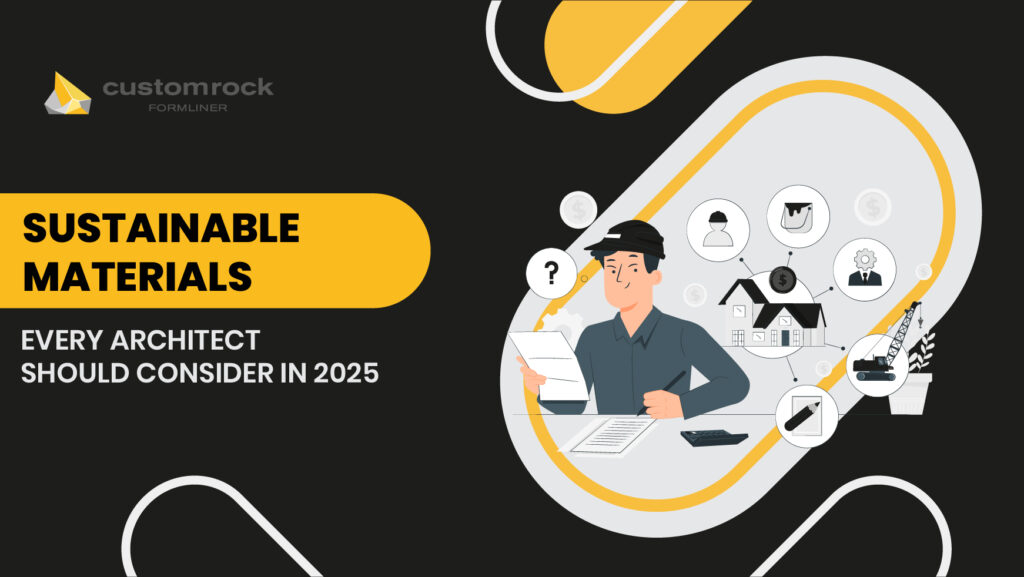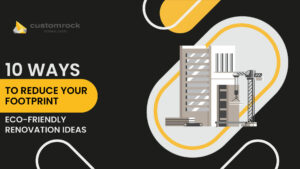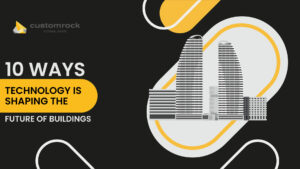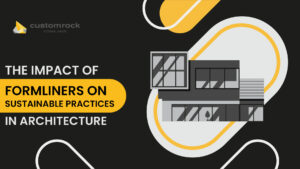TL; DR
As climate change reshapes our world, architects are changing the way how buildings are made. Architects are now moving towards eco-friendly materials such as bamboo, reclaimed wood, and mushroom-based composites.
With resources scarce and extreme weather becoming the new norm, the industry is waking up to a simple truth: every brick, beam, and bolt carries a carbon footprint.
Architects are not just building anymore; they’re problem-solving. The big question? “How do we make this structure a net win for the planet, not just a neutral?”
Sustainable materials are forcing the industry to change traditional practices. This is making construction smarter, greener, and more efficient.
CLT is proving that wood can be as strong as steel. On the other hand, hempcrete offers insulation without hindering the environment.
Mycelium and algae-based solutions might seem unconventional, yet they are already redefining material science. Even old techniques like rammed earth are making a comeback. This proves that sustainability is about reinvention, adoption, and refinement.
The question is not whether we can build sustainably, it’s whether we will. With these materials, we have the tools to create a future where buildings benefit the environment rather than harm it.
Today’s decisions determine the future of our built environment for generations. Using sustainable materials is essential for creating a lasting greener and better future.
Sustainable Material Every Architect Should Consider in 2025

Climate change is reshaping how we build. In 2025, architecture is not just about designing structures but also about protecting our planet.
Buildings account for nearly 40% of global carbon emissions, and architects now face a critical challenge: to create spaces that meet human needs without harming the environment.
The solution? Sustainable materials. Once seen as optional, these eco-friendly alternatives—like bamboo, recycled steel, or hempcrete—are now essential tools. They cut emissions, reduce waste, and help buildings “give back” to the Earth instead of taking from it.
This article breaks down the top materials architects should use in 2025 to design greener, smarter, and future-proof projects.
1. Cross-Laminated Timber (CLT)
Companies worldwide now adopt cross-laminated timber (CLT) due to its popularity as a substitute for concrete and steel. This engineered wood is layered and glued at right angles, making it strong, fire-resistant, and, best of all, sustainable
CLT locks in carbon which makes it a great choice for architects looking to build big without damaging the planet. CLT construction is faster and generates less waste than traditional building methods.
Many skyscrapers are now being constructed entirely from CLT. This proves that wood isn’t just for cottages but it is the future of urban architecture.
Fun Fact: CLT structures can be built 25% faster than concrete ones. The Ascent Building in Milwaukee (25 stories, the world’s tallest timber tower) took just 18 months to complete.
Why it’s cool:
- Builds faster, cuts waste.
- Feels warm and cozy (unlike chilly concrete)
2. Hempcrete
Imagine a building material that’s lightweight, breathable, and naturally resistant to mold and pests. That’s hempcrete. Made from hemp and lime, this biocomposite is a powerhouse insulator that reduces heating and cooling needs.
Plus, hemp grows insanely fast, making it one of the most sustainable crops on the planet. Not only is hempcrete an excellent alternative for insulation, but it’s also durable and completely biodegradable.
Unlike conventional insulation materials that release harmful VOCs, hempcrete is non-toxic and actively absorbs CO2 throughout its life cycle, making it one of the most promising green building materials available today.
3. Recycled Materials
Why produce new materials when we have tons of old that we can reuse? Reclaimed wood, steel, and brick are making a comeback in 2025.
Reclaimed materials are not just for aesthetics, they also have practical uses too. Recycled steel, for instance, retains all the strength of newly manufactured steel while significantly reducing the energy required for production.
Did you know: 1 ton of recycled plastic saves 16 barrels of oil?
4. Mycelium: The Fungal Frontier
I know this sounds crazy, but fungi might just replace plastic. Mycelium, the root structure of mushrooms, can be grown into insulation panels, bricks, and even furniture.
It’s biodegradable, lightweight, and has killer thermal properties. Plus, telling people your house is made of mushrooms is an instant conversation starter.
Beyond insulation, mycelium composites are being tested for their fire-resistant properties and durability. These bio-based materials have the potential to replace foam, plastic, and even some synthetic building materials.
They can be grown quickly with minimal resources, making them an excellent solution for sustainable construction.
Why is good?
- Zero Waste: Mycelium products compost in 180 days.
- Fireproof: Withstands temps up to 1,400°F (plastic melts at 200°F).
- Affordable: Mycelium bricks cost 50% less than concrete.
Limitations:
- Durability: Still testing for multi-decade use in wet climates.
5. Bamboo: The Fast-Growing All-Rounder
Bamboo is strong, flexible, and grows at an insane rate. It can be harvested every three to five years; making it a sustainable superstar. Prefabricated bamboo panels are already becoming a thing, offering a sleek and eco-friendly alternative to traditional materials.
With its natural anti-bacterial properties and ability to thrive in a variety of climates, bamboo is being used in everything from structural supports to flooring and even roofing materials. It’s no wonder bamboo is becoming the go-to choice for eco-conscious architects and builders worldwide.
Fun fact: Bamboo Steel Composites are hybrid beams that are lighter and cheaper.
6. Ferrock: The Concrete Alternative
Concrete is terrible for the environment. Enter Ferrock, a concrete alternative made from recycled steel dust. It’s not just strong—it absorbs CO2 from the air, making it carbon-negative. Stronger than traditional concrete and better for the planet? It’s a no-brainer.
Ferrock is particularly useful for high-strength applications, such as load-bearing walls and foundations. Its unique composition allows it to be more flexible and crack-resistant than conventional concrete, making it an excellent choice for sustainable infrastructure projects.
Key Advantages:
- 5x Stronger than traditional concrete.
- Carbon Negative: Absorbs 5x more CO2 than it emits during production.
- Made from Waste: Uses industrial byproducts (steel dust, glass shards).
Main Challenge: Still scaling production—only 12 factories globally as of 2024.
7. Transparent Wood: A Sustainable Glass Alternative
Glass is overrated. Transparent wood combines the durability of hardwood with the clarity of glass, offering better insulation and lower energy costs. It’s still in the early stages, but expect to see more of it in futuristic buildings.
By chemically treating and modifying natural wood fibers, transparent wood offers a stronger, shatter-resistant alternative to traditional glass. Its enhanced thermal insulation makes it ideal for windows and skylights, reducing energy consumption in homes and commercial spaces.
Why It’s Good:
- Better Than Glass: 5x stronger, 3x more insulating, and shatterproof.
- Made from Fast-Growing Pine: Sustainable and cheap.
Fun Fact: It was invented by accident in 2016 by a researcher cleaning wood with bleach!
8. Cork: The Versatile Material
Cork is waterproof, fire-resistant, and has excellent acoustic properties, making it ideal for flooring, walls, and even roofing. Plus, it’s harvested without killing the tree, meaning it’s as sustainable as it gets.
With its ability to absorb sound and resist moisture, cork is becoming a popular material for interior applications. It provides a soft, natural feel underfoot while contributing to indoor air quality with its non-toxic, hypoallergenic properties.
Plus: It’s naturally anti-microbial which makes it perfect for kitchens and rooms.
9. Algae-Based Materials
Did you know that algae is more than just pond scum? It’s being transformed into bioplastics, bio-cements, and even energy-generating facades. It absorbs CO2 as it grows, making it an environmental win.
Incorporating algae-based materials into architecture is not just about sustainability but also about innovation. Living algae facades, for example, can act as biofilters, producing oxygen while shading buildings and improving urban air quality.
Why it’s great: It grows with sunlight and CO2. Zero effort, all reward.
10. Rammed Earth
Rammed earth construction has been around for millennia, and with good reason. It’s durable, has low carbon, and offers incredible thermal insulation. Modern architects are using this ancient technique which shows that sometimes old-school tactics just work.
With new advancements in engineering, rammed earth is being used with natural stabilizers to improve strength and longevity. This makes it a viable alternative to the usual concrete in construction used today.
Fun Fact: Rammed earth walls regulate humidity naturally. No dehumidifiers are needed!
Real-World Examples: Sustainable Materials in Action
-
The Edge (Amsterdam, Netherlands)
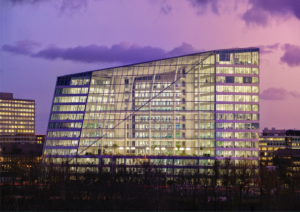
Can you Imagine an office building that powers itself? The Edge is not just a workspace but a sustainability powerhouse. It has cross-laminated timber (CLT) floors that lock away carbon, solar panels that power up the entire building (plus a few neighboring homes), and an underground system that stores summer heat for winter use.
Plus it also has sensors that adjust lighting and temperature based on who’s in the room. The Edge scored a jaw-dropping 98.4% on the LEED Platinum scale.
-
Bullitt Center (Seattle, USA)
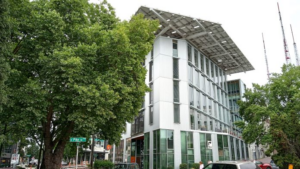
Made of hempcrete—a mix of hemp and lime that keeps interiors cozy without wasting energy. The solar panels power everything in this building, from laptops to lights.
-
Bosco Verticale (Milan, Italy)

The structure is cloaked in 20,000+ plants and bamboo screens, Bosco Verticale scrubs CO2 from Milan’s smoggy air like a giant air purifier. Many critics called it a “stunt”. However, it won the International Highrise Award and reduced the urban heat effect by 2°C
-
The Cube (Berlin, Germany)
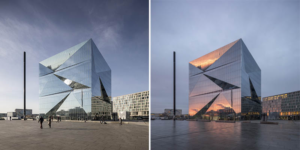
The Cube in Berlin, Germany is another excellent example of an eco-friendly building. This innovative structure uses mycelium (mushroom roots) to create walls that are fireproof, biodegradable, and made from agricultural waste.
The structure cuts down 93% of carbon if we compare it to traditional concrete structures and also costs 20% less to make
Frequently Asked Questions (FAQs)
Q: Are sustainable materials more expensive?
A: Initially, yes. But they pay off long-term. CLT buildings save 15–20% on energy bills, and hempcrete cuts HVAC costs by 50%. By 2025, prices are projected to drop as demand grows.
Q: What’s stopping everyone from going green?
A: Scaling production and outdated building codes. But policies like California’s Buy Clean Act are pushing industries to adopt low-carbon materials.
Q: How can I support sustainable architecture?
A: Choose reclaimed wood for home projects, advocate for green policies, or hire architects with LEED certifications.

